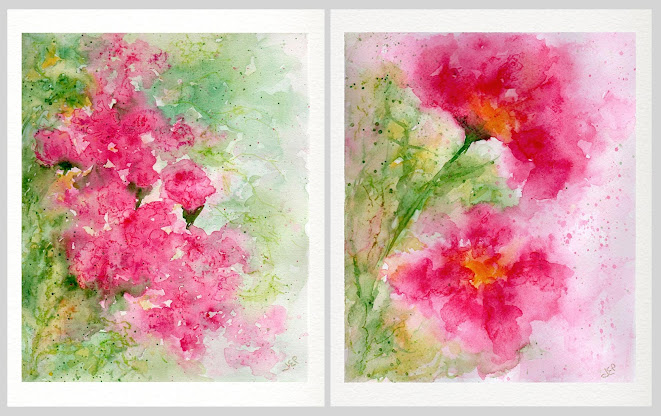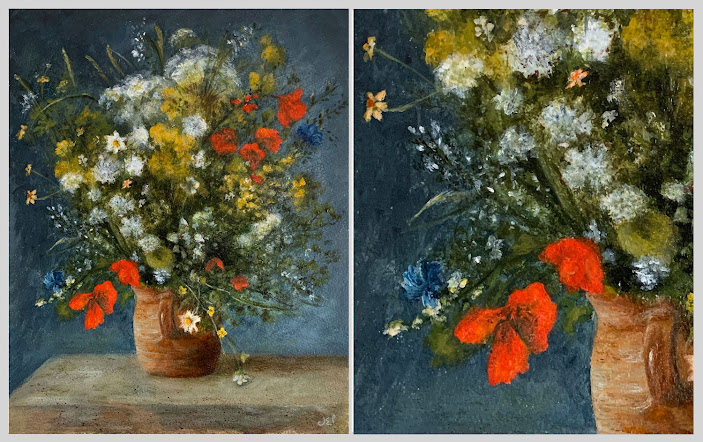
|
Sweet Dreams | Jane E Porter
|
I've always had a deep love for nature, and it's been an ongoing source of inspiration. But, after a quiet dalliance with landscape painting, I quickly realised it wasn’t my forte. However, the natural world offers a rich source of symbols and metaphors, which provide a plethora of opportunities to add them as storytelling elements.
One of the most poignant metaphors I find in nature is the cycle of impermanence. Just as flowers bloom and wither, everything in life has its season. Deepak Chopra once referred to being, ‘in the Autumn’ of his life which I found very meaningful and endearing.
Just like the natural world, life is filled with periods of growth and dormancy, light and darkness. In the bitter chill of winter, nature rests, conserving energy for the rebirth of spring. She reminds us that no matter how dark or challenging life can become, there is the possibility to start over, to bloom again.
And nature is everywhere. As humans, we are inextricably linked to her, as we depend on plants, animals and microorganisms. As artists (and humans 😉) she generously offers an endless source of material to study, paint and write about. The flower doesn’t mind if I photograph her or capture her best side unlike painting a portrait where the stakes can be very high.
My latest painting 'Sweet Dreams' led me to research the symbolism associated with the flower and come up with the title. Symbolism can be subjective; attaching your meaning is as important as the artist’s intention. Below are a variety of interpretations of poppies I think you’ll find interesting:
Poppies: Facts, Fiction and Symbolism
Papaver somniferum L., commonly known as the opium poppy or breadseed poppy, is a medicinal plant known to the human race since ancient civilizations. Inside the seed pod is an opaque, milky sap. This is opium in its crudest form. Opium is a powerful narcotic whose derivatives include morphine, codeine, heroin, and oxycodone. ‘Narcotic’ refers to opium, opium derivatives, and their semi-synthetic substitutes, used therapeutically to treat pain, suppress cough and induce anaesthesia. They are some of the most addictive substances known to man.
Sleep
In Greek and Roman myths, poppies were used as offerings to the dead and used as emblems on tombstones. They symbolised eternal sleep because of the sedative qualities of opium.
Hypnos, the god of sleep, often holds a poppy or places poppy flowers on someone’s head to help them sleep. Demeter, the goddess of agriculture, also used poppies to help people sleep and find rest from their troubles.
In The Wizard of Oz, poppies had a memorable story element:
‘And now my beauties, something with poison in it I think, with poison in it, but attractive to the eye and soothing to the smell . . . poppies, poppies, poppies will put them to sleep.’ The Wicked Witch of the West, The Wizard of Oz (movie, released 1939).
‘Now it is well known that when there are many of these flowers together their odour is so powerful that anyone who breathes it falls asleep, and if the sleeper is not carried away from the scent of the flowers, he sleeps on and on forever...’ Excerpt from The Wonderful Wizard of Oz (book, published 1900)
Sleep and Dreams
Morpheus, meaning transformation, was the son of Hypnos and the god of dreams. His attributes included a horn of sleep-inducing opium. Morphine, an opium derivative, gets its name from Morpheus.
The Greek gods often chose him as their messenger to appear in the dreams of mortals. Dreams could liberate the desires, hopes, and imaginations of the sleeper and, upon waking, would motivate them toward action. However, some dreams could portray false realities, manipulating the receiver into untoward action.
Remembrance
The most common association with poppies today is remembrance, particularly for those who have died in war. This association is linked to historical events where scarlet corn poppies grew in soil disturbed by war. Poppies grew in fields across Europe during World War I, despite the destruction and death caused by the war.
Hope
Poppies are a metaphor for hope of a peaceful future. They thrive even in the poorest soil, rest during the winter and bloom again in the spring, the season of rebirth.
Resurrection
In Christianity, poppies symbolise the blood of Christ, his resurrection and his ascension. Poppies often grow where the earth has been disturbed and are connected to new life emerging from death or destruction. The Bible refers to the ‘flower of the field’, which could refer to any flower however poppies became part of Christian belief in popular culture and art.
Magic and Witchcraft
This is a true story! Poppies were used in spells and charms to create mental confusion and prevent rational thinking. The seeds are connected to the astrological sign of Gemini, the planets, Neptune and the moon, Ajna, also known as the third-eye chakra, associated with intuition, insight, spiritual awareness and feminine energy.
Thanks for reading until the end. I got quite lost in the symbolism research but learned a lot, pretty good for a late Friday afternoon.
Did you find the symbolism behind poppies intriguing? Do you have any thoughts or experiences of symbols and metaphors in art or other media you’d like to share? Please leave a comment below and keep the conversation going!
As always, have a wonderful weekend.
Janee x
Be The First to Know
To discover new works, insights from art history and the power of storytelling, Click here
For more art, follow me on Instagram and Facebook.
Jane E Porter is a fine artist and illustrator from Scotland, dedicated to exploring and understanding the fascinating interplay between art, psychology and philosophy. As she navigates her own search for meaning, she shares insights and observations made over the past two decades with a delightful mix of wit and wisdom. Join her as she continues her journey, delving into these themes, offering you fresh perspectives and insights on art, identity and storytelling.
Resources











